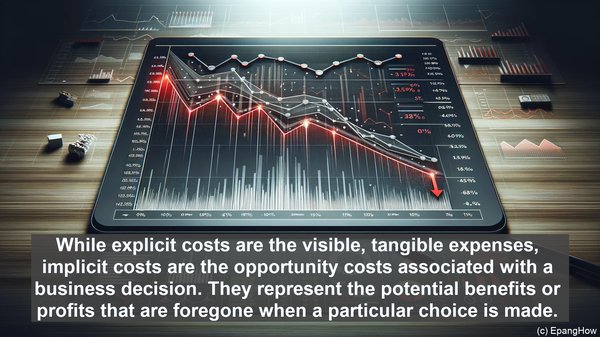Introduction: The World of Costs in Business Economics
Hello everyone, and welcome to our article on the intriguing world of costs in business economics. Costs are a fundamental aspect of any business, and understanding their nuances is crucial for making informed decisions. Today, we’ll be focusing on two types of costs: explicit costs and implicit costs. While they both contribute to the overall expenses, they differ in their nature and how they impact decision-making. So, let’s dive in!
Defining Explicit Costs: The Tangible Expenses
Explicit costs, also known as out-of-pocket costs, are the tangible expenses that a business incurs. These costs involve actual monetary transactions, such as wages, rent, utilities, raw materials, and advertising. They are the direct, measurable expenditures that can be easily accounted for in financial records. For example, when a company pays its employees, that’s an explicit cost. These costs are crucial for determining the profitability of a business and are often the focus of financial analysis.
Unraveling Implicit Costs: The Opportunity Expenses
While explicit costs are the visible, tangible expenses, implicit costs are the opportunity costs associated with a business decision. They represent the potential benefits or profits that are foregone when a particular choice is made. Implicit costs are not recorded in financial statements, but they are just as significant. Consider a scenario where an entrepreneur starts their own business. While the explicit costs may include rent and equipment, the implicit costs would encompass the salary they could have earned if they had taken a job instead. These opportunity costs, though not immediately apparent, play a crucial role in decision-making and resource allocation.
Significance of Explicit Costs: Tracking the Financial Health
Explicit costs are essential for tracking the financial health of a business. By meticulously recording these costs, businesses can assess their profitability, identify areas of overspending, and make informed budgetary decisions. Moreover, explicit costs are often used in cost-benefit analysis, where the potential gains of a particular action are weighed against the explicit costs involved. This analysis aids in determining the feasibility and viability of a project, investment, or expansion.

The Invisible Impact: Implicit Costs in Decision-Making
While explicit costs are crucial, decision-making in business economics is not solely driven by them. Implicit costs, with their intangible nature, often have a significant influence. When evaluating options, businesses must consider the potential opportunity costs. For instance, expanding a product line may require additional resources, which could mean diverting funds from another lucrative project. By factoring in the implicit costs, businesses can make more holistic decisions, weighing both the immediate gains and the long-term consequences.
Balancing Act: The Interplay of Explicit and Implicit Costs
In the dynamic world of business economics, it’s not just about explicit costs or implicit costs; it’s about finding the right balance. Businesses need to optimize their explicit costs, ensuring efficient resource allocation and cost control. At the same time, they must be cognizant of the implicit costs, avoiding decisions that may have long-term negative implications. Striking this balance is a constant challenge, but it’s one that successful businesses navigate adeptly.

